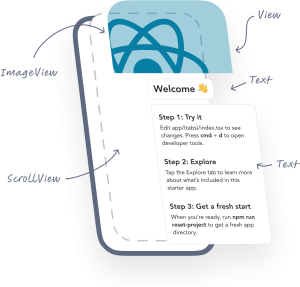Introduction
React Native has emerged as a revolutionary framework in the world of mobile app development, allowing developers to build natively rendered applications for iOS and Android using React and JavaScript. This blog will take you through the core architecture of React Native, its benefits, and how companies like Pinterest have successfully implemented it in their tech stacks. Whether you’re a seasoned developer or just starting out, understanding It’s can significantly enhance your ability to deliver high-quality, cross-platform mobile applications.
What is React Native?
React Native is an open-source framework developed by Meta (formerly Facebook) that enables developers to build mobile applications using JavaScript and React. Unlike other hybrid frameworks that rely on WebViews, it’s compiles JavaScript into native code, ensuring that apps deliver a truly native experience.
The main advantage of this technology is that it allows for the reuse of code across different platforms. This means that a significant portion of the code written for an iOS app can be used for the Android version, and vice versa, simplifying the development process and reducing time-to-market.
React Native’s Architecture
React Native’s architecture is a blend of JavaScript and native code, where the two communicate through a “bridge.” This bridge allows the JavaScript code to interact with the native components of the platform, such as the UI and device APIs.
How It Works:
- JavaScript Thread: This thread handles the business logic of the application, executing JavaScript and React code.
- Main Thread: This is the native thread responsible for rendering the UI and handling user interactions.
- Shadow Thread: Responsible for computing the layout of views and ensuring that the UI is displayed correctly across different screen sizes.
- Bridge: The bridge facilitates communication between the JavaScript and native layers. While this method is efficient, it can introduce latency in some cases, especially when dealing with complex UI updates.
React Native’s architecture also includes a new feature called the JavaScript Interface (JSI), which was introduced to improve performance by allowing direct communication between JavaScript and native code without the need for serialization and deserialization of data. This new architecture marks a significant improvement in how React Native apps are built and executed.
Real-World Application: Pinterest’s Journey with React Native
Pinterest’s engineers have always been keen on exploring the potential of React Native. When the framework debuted in 2015, they were intrigued by its promise of cross-platform development and decided to test it out by building a prototype of a critical onboarding feature – the Topic Picker.
The results were impressive. The iOS prototype took just ten days to develop, and the Android version required only two additional days. The engineers estimated that they saved over a week of standard development time, with no compromise on performance for either platform. Satisfied with the outcomes, Pinterest decided to incorporate React Native permanently into their tech stack. Today, it’s powers not only the Topic Picker but also Pinterest’s Business Signup sequence.
Benefits of Using React Native
React Native offers a plethora of advantages, making it a popular choice among developers and companies alike.

1. Code Reusability:
React Native allows developers to reuse up to 90% of their code across iOS and Android platforms. This drastically reduces development time and costs, as there is no need to maintain separate codebases for different platforms. Engineers at Discord echoed this sentiment, sharing how they managed to get their comprehensive iOS app running on Android within just two days using it.
2. Large Developer Community:
Being an open-source framework, React Native benefits from a vast and active developer community. If developers encounter issues while building apps, they can turn to this community for support. As of mid-2020, nearly 50,000 contributors were active on Stack Overflow, helping others resolve problems and improve their coding skills.
3. Cost Efficiency:
React Native’s ability to share code across platforms means that businesses do not need to hire separate teams for iOS and Android development. A smaller team can manage the entire project, leading to significant cost savings.
4. Fast Refresh:
The Fast Refresh feature in React Native allows developers to see changes immediately without having to rebuild the entire app. This results in significant time savings and boosts productivity, as developers can iterate quickly and efficiently.
5. Simple UI:
It’s uses React’s declarative UI paradigm, which results in a more responsive and faster user interface. Whether you’re building a simple or complex app, it’s component-based architecture makes UI development straightforward and intuitive.
6. Future-Proof:
It’s growing popularity and continuous improvements make it a future-proof choice for cross-platform app development. The introduction of the JSI in the new architecture addresses previous performance concerns, ensuring that it remains a competitive option for building high-performance mobile apps.
Challenges and the Evolution of React Native
While React Native offers numerous benefits, it is not without its challenges. One of the main issues with the original architecture was the performance bottleneck caused by the asynchronous nature of the bridge. This could lead to noticeable lag in certain situations, such as handling complex UI updates or processing large amounts of data.
To address these challenges, the React Native team introduced the JavaScript Interface (JSI) in version 0.68. JSI allows JavaScript to interact directly with native code, bypassing the bridge and enabling synchronous communication. This improvement significantly enhances the performance and reliability of React Native applications.
Conclusion
React Native is a powerful framework that bridges the gap between web and mobile development, allowing developers to create high-quality, cross-platform apps with ease. Its code reusability, large community support, and cost efficiency make it an attractive choice for businesses and developers alike.
As React Native continues to evolve, it is poised to remain a dominant force in the mobile development landscape. Whether you’re a seasoned developer or just starting out, learning it can open up new opportunities and enhance your ability to deliver top-notch mobile applications.
So, if you haven’t already, it’s time to dive into React Native and start building the next generation of mobile apps. With its robust architecture, extensive community support, and future-proof features, It is the framework that can take your development skills to the next level. For more details about this topic visit the Mobile App Development category of Tech Cyb or official site.
Summery:
Delve into the world of React Native, the framework revolutionizing mobile app development. This blog explores its unique architecture, the myriad benefits it offers developers, and how companies like Pinterest have seamlessly integrated it into their tech stacks. Discover why React is a game-changer for cross-platform development, offering code reusability, cost efficiency, and a large developer community. Whether you’re a seasoned developer or new to mobile app development, learn how React Native can accelerate your projects and future-proof your skills.
